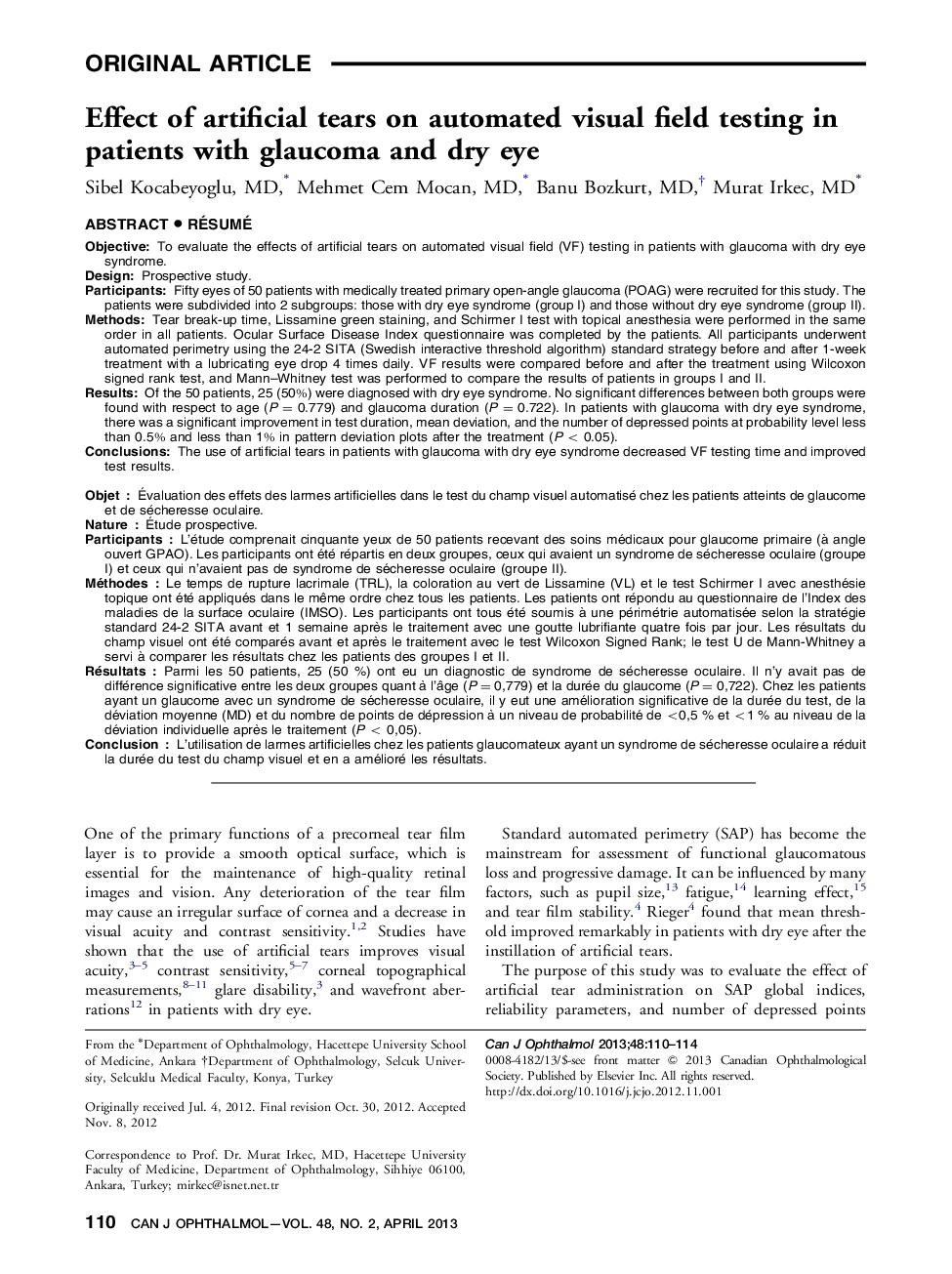| کد مقاله | کد نشریه | سال انتشار | مقاله انگلیسی | نسخه تمام متن |
|---|---|---|---|---|
| 4009220 | 1602410 | 2013 | 5 صفحه PDF | دانلود رایگان |

ObjectiveTo evaluate the effects of artificial tears on automated visual field (VF) testing in patients with glaucoma with dry eye syndrome.DesignProspective study.ParticipantsFifty eyes of 50 patients with medically treated primary open-angle glaucoma (POAG) were recruited for this study. The patients were subdivided into 2 subgroups: those with dry eye syndrome (group I) and those without dry eye syndrome (group II).MethodsTear break-up time, Lissamine green staining, and Schirmer I test with topical anesthesia were performed in the same order in all patients. Ocular Surface Disease Index questionnaire was completed by the patients. All participants underwent automated perimetry using the 24-2 SITA (Swedish interactive threshold algorithm) standard strategy before and after 1-week treatment with a lubricating eye drop 4 times daily. VF results were compared before and after the treatment using Wilcoxon signed rank test, and Mann–Whitney test was performed to compare the results of patients in groups I and II.ResultsOf the 50 patients, 25 (50%) were diagnosed with dry eye syndrome. No significant differences between both groups were found with respect to age (P = 0.779) and glaucoma duration (P = 0.722). In patients with glaucoma with dry eye syndrome, there was a significant improvement in test duration, mean deviation, and the number of depressed points at probability level less than 0.5% and less than 1% in pattern deviation plots after the treatment (P< 0.05).ConclusionsThe use of artificial tears in patients with glaucoma with dry eye syndrome decreased VF testing time and improved test results.
RésuméObjetÉvaluation des effets des larmes artificielles dans le test du champ visuel automatisé chez les patients atteints de glaucome et de sécheresse oculaire.NatureÉtude prospective.ParticipantsL'étude comprenait cinquante yeux de 50 patients recevant des soins médicaux pour glaucome primaire (à angle ouvert GPAO). Les participants ont été répartis en deux groupes, ceux qui avaient un syndrome de sécheresse oculaire (groupe I) et ceux qui n'avaient pas de syndrome de sécheresse oculaire (groupe II).MéthodesLe temps de rupture lacrimale (TRL), la coloration au vert de Lissamine (VL) et le test Schirmer I avec anesthésie topique ont été appliqués dans le même ordre chez tous les patients. Les patients ont répondu au questionnaire de l'Index des maladies de la surface oculaire (IMSO). Les participants ont tous été soumis à une périmétrie automatisée selon la stratégie standard 24-2 SITA avant et 1 semaine après le traitement avec une goutte lubrifiante quatre fois par jour. Les résultats du champ visuel ont été comparés avant et après le traitement avec le test Wilcoxon Signed Rank; le test U de Mann-Whitney a servi à comparer les résultats chez les patients des groupes I et II.RésultatsParmi les 50 patients, 25 (50 %) ont eu un diagnostic de syndrome de sécheresse oculaire. Il n'y avait pas de différence significative entre les deux groupes quant à l'âge (P = 0,779) et la durée du glaucome (P = 0,722). Chez les patients ayant un glaucome avec un syndrome de sécheresse oculaire, il y eut une amélioration significative de la durée du test, de la déviation moyenne (MD) et du nombre de points de dépression à un niveau de probabilité de <0,5 % et <1 % au niveau de la déviation individuelle après le traitement (P < 0,05).ConclusionL'utilisation de larmes artificielles chez les patients glaucomateux ayant un syndrome de sécheresse oculaire a réduit la durée du test du champ visuel et en a amélioré les résultats.
Journal: Canadian Journal of Ophthalmology / Journal Canadien d'Ophtalmologie - Volume 48, Issue 2, April 2013, Pages 110–114